Cardinal Richelieu
 From Nwe
From Nwe
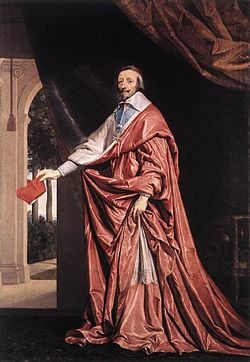
Armand Jean du Plessis de Richelieu, Cardinal-Duc de Richelieu (September 9, 1585 – December 4, 1642), was a French clergyman, noble, and statesman. He was consecrated as a bishop in 1607, he later entered politics, becoming a Secretary of State in 1616. Richelieu soon rose in both the Church and the state, becoming a cardinal in 1622, and King Louis XIII's chief minister in 1624. He remained in office until his death in 1642; he was succeeded by Jules Cardinal Mazarin.
The Cardinal de Richelieu was often known by the title of the King's "Chief Minister." He sought to consolidate royal power and crush domestic factions. By restraining the power of the nobility, he transformed France into a strong, centralized state. His chief foreign policy objective was to check the power of the Austro-Spanish Habsburg dynasty. Although he was a Roman Catholic cardinal, he did not hesitate to make alliances with Protestant rulers in attempting to achieve this goal. His tenure was marked by the Thirty Years' War that engulfed Europe.
As an advocate for Samuel de Champlain and of the retention of Québec, he founded the Compagnie des Cent-Associés and saw the Treaty of Saint-Germain-en-Laye return Québec to French rule under Champlain, after the settlement had been captured by the Kirkes in 1629. This in part allowed the colony to eventually develop into the heartland of Francophone culture in North America.
Early life
Richelieu was born in Paris on September 9, 1585, he was the fourth of five children and the last of three sons. His family, although belonging only to the lesser nobility of Poitou, was somewhat prominent: His father, François du Plessis, seigneur de Richelieu, was a soldier and courtier who served as the Grand Provost of France; his mother, Susanne de La Porte, was the daughter of a famous jurist. When Armand was only five years old, his father died fighting in the French Wars of Religion, leaving the family in debt; with the aid of royal grants, however, the family was able to avoid financial difficulties.
Richelieu was a bright child and excelled at his studies. At the age of nine was sent to College de Navarre in Paris. Later at the age of seventeen he began studying theology. In 1606, King Henry IV nominated Richelieu to become Bishop of Luçon. As Richelieu had not yet reached the official minimum age, it was necessary that he journey to Rome to obtain a special dispensation from the Pope. The agreement of the Pope having been secured, Richelieu was consecrated bishop in April 1607. Soon after he returned to his diocese in 1608, Richelieu was heralded as a reformer; he became the first bishop in France to implement the institutional reforms prescribed by the Council of Trent between 1545 and 1563.
Rise to power
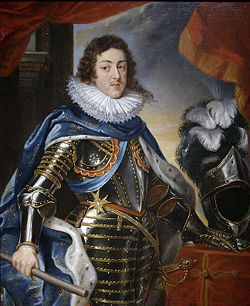
In 1614, the clergymen of Poitou elected Richelieu as one of their representatives to the States-General. There, he was a vigorous advocate of the Church, arguing that it should be exempt from taxes and that bishops should have more political power. He was the most prominent clergyman to support the adoption of the decrees of the Council of Trent throughout France; the Third Estate (commoners) was his chief opponent in this endeavor. At the end of the assembly, the First Estate (the clergy) chose him to deliver the address enumerating its petitions and decisions. Soon after the dissolution of the States-General, Richelieu entered the service of King Louis XIII's wife, Anne of Austria, as her almoner.
Richelieu advanced politically by faithfully serving Concino Concini, the most powerful minister in the kingdom. In 1616, Richelieu was made Secretary of State, and was given responsibility for foreign affairs. Like Concini, the Bishop was one of the closest advisors of Louis XIII's mother, Marie de Médicis. Queen Marie had become Regent of France when the nine-year old Louis ascended the throne; although her son reached the legal age of majority in 1614, she remained the effective ruler of the realm. However, her policies, and those of Concini, proved unpopular with many in France. As a result, both Marie and Concini became the targets of intrigues at court; their most powerful enemy was Charles de Luynes. In April 1617, in a plot arranged by Luynes, King Louis XIII ordered that Concini be arrested, and killed should he resist; Concini was consequently assassinated, and Marie de Médicis overthrown. His patron having died, Richelieu also lost power; he was dismissed as Secretary of State, and was removed from the court. In 1618, the King, still suspicious of the Bishop of Luçon, banished him to Avignon. There, Richelieu spent most of his time writing; he composed a catechism entitled L'Instruction du chrétien.
In 1619, Marie de Médicis escaped from her confinement in the Château de Blois, becoming the titular leader of an aristocratic rebellion. The King and the duc de Luynes recalled Richelieu, believing that he would be able to reason with the Queen. Richelieu was successful in this endeavor, mediating between Marie and her son. Complex negotiations bore fruit when the Treaty of Angoulême was ratified; Marie de Médicis was given complete freedom, but would remain at peace with the King. The Queen was also restored to the royal council.
After the death of the duc de Luynes, in 1621, Richelieu began to rise to power quickly. Next year, the King nominated Richelieu for a cardinalate, which Pope Gregory XV accordingly granted on April 19, 1622. Crises in France, including a rebellion of the Huguenots, rendered Richelieu a nearly indispensable advisor to the King. After he was appointed to the royal council of ministers in April 1624, he intrigued against the chief minister, Charles, duc de La Vieuville. In August of the same year, La Vieuville was arrested on charges of corruption, and Cardinal Richelieu took his place as the King's principal minister.
Chief minister
Cardinal Richelieu's policy involved two primary goals: centralization of power in France and opposition to the Habsburg dynasty (which ruled in both Austria and Spain). Shortly after he became Louis's principal minister, he was faced with a crisis in the Valtellina, a valley in Lombardy (northern Italy). In order to counter Spanish designs on the territory, Richelieu supported the Protestant Swiss canton of Grisons, which also claimed the strategically important valley. The Cardinal deployed troops to Valtellina, from which the Pope's garrisons were driven out. Richelieu's decision to support a Protestant canton against the Pope won him many enemies in predominantly Catholic France.
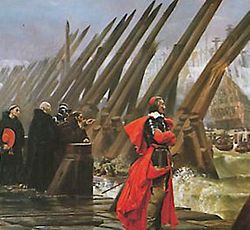
In order to further consolidate power in France, Richelieu sought to suppress the influence of the feudal nobility. In 1626, he abolished the position of Constable of France and he ordered all fortified castles to be razed, excepting only those needed to defend against invaders. Thus, he stripped the princes, dukes, and lesser aristocrats of important defenses that could have been used against the King's armies during rebellions. As a result, Richelieu was became disliked by most of the nobility.
Another obstacle to the centralization of power was religious division in France. The Huguenots, one of the largest political and religious factions in the country, controlled a significant military force, and were in rebellion. Moreover, the English king, Charles I, declared war on France in an attempt to aid the Huguenot faction. In 1627, Richelieu ordered the army to besiege the Huguenot stronghold of La Rochelle; the Cardinal personally commanded the besieging troops. English troops under the Duke of Buckingham led an expedition to help the citizens of La Rochelle, but failed abysmally. The city, however, remained firm for over a year before capitulating in 1628.
Although the Huguenots suffered a major defeat at La Rochelle, they continued to fight, led by Henri, duc de Rohan. Protestant forces, however, were defeated in 1629; Rohan submitted to the terms of the Peace of Alais. As a result, religious toleration for Protestants, which had first been granted by the Edict of Nantes in 1598, was permitted to continue; however, the Cardinal abolished their political rights and protections. Rohan was not executed (as were leaders of rebellions later in Richelieu's tenure); in fact, he later became a commanding officer in the French army.
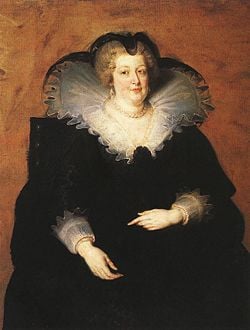
In the next year, Richelieu's position was seriously threatened by his former patron, Marie de Médicis. Marie believed that the Cardinal had robbed her of her political influence; thus, she demanded that her son dismiss the chief minister. Louis XIII was not, at first, averse to such a course of action, for his relations with the Cardinal were poor. The King disliked Richelieu, but the persuasive statesman was capable of convincing his master of the wisdom in his plans. On November 11, 1630, Marie de Médicis and the King's brother, Gaston, duc d'Orléans, secured the King's agreement for the dismissal. Cardinal Richelieu, however, was aware of the plan, and quickly convinced the King to repent. This day, known as the Day of the Dupes, was the only one on which Louis XIII took a step toward dismissing his minister. Thereafter, the King, although continuing to dislike Richelieu, was unwavering in his political support for him; the courtier was created duc de Richelieu and was made a Peer of France.
Thirty Years' War
Before Richelieu's ascent to power, most of Europe had become involved in the Thirty Years' War. In 1629, the Habsburg Holy Roman Emperor humbled many of his Protestant opponents in Germany, thereby greatly increasing his power. Cardinal Richelieu, alarmed by the Emperor Ferdinand II's influence, incited Sweden to attack. He also agreed to aid King Gustavus II Adolphus of Sweden with financial subsidies. France was not openly at war with the Empire, so aid was given secretly. In the meantime, France and Spain continued to remain hostile over the latter kingdom's ambitions in northern Italy. At that time Northern Italy was a major strategic asset in Europe's balance of powers, being a terrestrial link between the Habsburg's two branches in Germany and Spain. Had the imperial armies dominated this region, France's very existence would have been endangered, being circled by Habsburg territories. Spain was then aspiring for becoming a "universal monarchy," with support from the Pope. When, in 1630, French ambassadors in Regensburg agreed to make peace with Habsburg Spain, Richelieu refused to uphold them. The agreement would have prohibited French interference in the hostilities in Germany. Thus, Richelieu advised Louis XIII to refuse to ratify the treaty.
Last years
Towards the end of his life, Richelieu managed to alienate many individuals, including the Pope. Richelieu was displeased by Pope Urban VIII's refusal to name him the papal legate in France; in turn, the Pope did not approve of the administration of the French church, or of French foreign policy. However, the conflict was largely healed when the Pope granted a cardinalate to Jules Mazarin, one of Richelieu's foremost political allies, in 1641. Despite troubled relations with the Roman Catholic Church, Richelieu did not support the complete repudiation of papal authority in France, as was advocated by the Gallicanists.
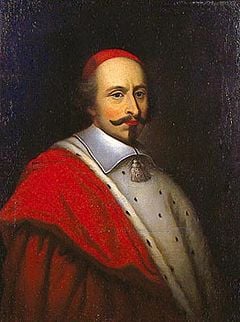
As he neared his death, Cardinal Richelieu faced a plot that threatened to remove him from power. The cardinal had introduced a young man named Henri Coiffier de Ruzé, marquis de Cinq-Mars to Louis XIII's court. The Cardinal had been a friend of Cinq-Mars' father. More importantly, Richelieu hoped that Cinq-Mars would become Louis' favorite, so that he could indirectly exercise greater influence over the monarch's decisions. Cinq-Mars had become the royal favorite by 1639, but, contrary to Cardinal Richelieu's belief, he was not easy to control. The young marquis realized that Richelieu would not permit him to gain political power. In 1641, he participated in the comte de Soissons' failed conspiracy against Richelieu, but was not discovered. Next year, he schemed with leading nobles (including the King's brother, the duc d'Orléans) to raise a rebellion; he also signed a secret agreement with the King of Spain, who promised to aid the rebels. Richelieu's spy service, however, discovered the plot, and the Cardinal received a copy of the treaty. Cinq-Mars was promptly arrested and executed; although Louis approved the use of capital punishment, he grew more distant from Richelieu as a result.
In the same year, however, Richelieu's health was already failing. The Cardinal suffered greatly from eye strain and headaches, among other ailments. As he felt his death approaching, he named as his successor one of his most faithful followers, Jules Cardinal Mazarin. Although Mazarin was originally a representative of the Holy See, he had left the Pope's service to join that of the King of France. Mazarin succeeded Richelieu upon his death December 4, 1642. The Cardinal is interred at the church of the Sorbonne.
Arts and culture
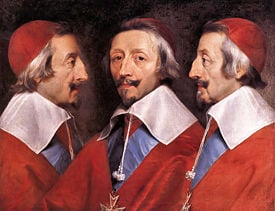
Cardinal Richelieu was a famous patron of the arts. Himself an author of various religious and political works (most notably his Political Testament), he funded the literary careers of many writers. He was a lover of the theater, which was not considered a respectable art form during that era. Among the individuals he patronized was the famous playwright Pierre Corneille. Richelieu was also the founder and patron of the Académie française, the pre-eminent French literary society. The institution had previously been in informal existence; in 1635, however, Cardinal Richelieu obtained official letters patent for the body. The Académie française includes forty members, promotes French literature, and continues to be the official authority on the French language. Richelieu served as the Académie's "protector;" since 1672, that role has been fulfilled by the French head of state.
In 1622, Richelieu was elected the proviseur or principal of the Sorbonne. He presided over the renovation of the college's buildings, and over the construction of its famous chapel, where he is now entombed. As he was Bishop of Luçon, his statue stands outside the Luçon cathedral.
Legacy
Richelieu's tenure was a crucial period of reform for France. Earlier, the nation's political structure was largely feudalistic, with powerful nobles and a wide variety of laws in different regions. Parts of the nobility periodically conspired against the King, raised private armies, and allied themselves with foreign powers. This haphazard system gave way to centralized power under Cardinal Richelieu. Local and even religious interests were subordinated to those of the whole nation, and of the embodiment of the nation—the King. Equally critical for France was Richelieu's foreign policy, which helped restrain Habsburg influence in Europe. Richelieu did not survive until the end of the Thirty Years' War however, the conflict ended in 1648, with France emerging in a far better position than any other power, and the Holy Roman Empire entering a period of decline.
Cardinal Richelieu's successes were extremely important to Louis XIII's successor, King Louis XIV. Louis XIV continued Richelieu's work of creating an absolute monarchy; in the same vein as the Cardinal, he enacted policies that further suppressed the once-mighty aristocracy, and utterly destroyed all remnants of Huguenot political power with the Edict of Fontainebleau. Moreover, Louis took advantage of his nation's success during the Thirty Years' War to establish French hegemony in continental Europe. Thus, Richelieu's policies were the requisite prelude to Louis XIV becoming the most powerful monarch, and France the most powerful nation, in all of Europe during the late seventeenth century.
References
ISBN links support NWE through referral fees
- Belloc, Hilaire. Richelieu; a Study. Westport, Conn: Greenwood Press 1972. ISBN 9780837147628
- Brockliss, L. W. B. Richelieu and his Age. Oxford: Clarendon Press 1992. ISBN 9780198202318
- Church, William Farr. Richelieu and Reason of State. Princeton, N.J.: Princeton University Press 1973. ISBN 9780691051994
- Levi, Anthony. Cardinal Richelieu and the Making of France. New York: Carroll & Graf, 2000. ISBN 9780786707782
- Lodge, Richard. Richelieu. London: Macmillan and Co., Ltd., 1896. ISBN 9780804610797
- Richelieu, Armand Jean du Plessis. Political Testament of the Cardinal Richelieu. Madison: University of Wisconsin Press 1961. ISBN 9780299024246
External links
All links retrieved January 10, 2017.
- Goyau, Georges. (1912). "Armand-Jean du Plessis, Duke de Richelieu." The Catholic Encyclopedia, Volume XIII. New York: Robert Appleton Company.
Credits
New World Encyclopedia writers and editors rewrote and completed the Wikipedia article in accordance with New World Encyclopedia standards. This article abides by terms of the Creative Commons CC-by-sa 3.0 License (CC-by-sa), which may be used and disseminated with proper attribution. Credit is due under the terms of this license that can reference both the New World Encyclopedia contributors and the selfless volunteer contributors of the Wikimedia Foundation. To cite this article click here for a list of acceptable citing formats.The history of earlier contributions by wikipedians is accessible to researchers here:
- Cardinal Richelieu history
The history of this article since it was imported to New World Encyclopedia:
- History of "Cardinal Richelieu"
Note: Some restrictions may apply to use of individual images which are separately licensed.
↧ Download as ZWI file | Last modified: 02/04/2023 02:02:50 | 197 views
☰ Source: https://www.newworldencyclopedia.org/entry/Cardinal_Richelieu | License: CC BY-SA 3.0
 ZWI signed:
ZWI signed: KSF
KSF